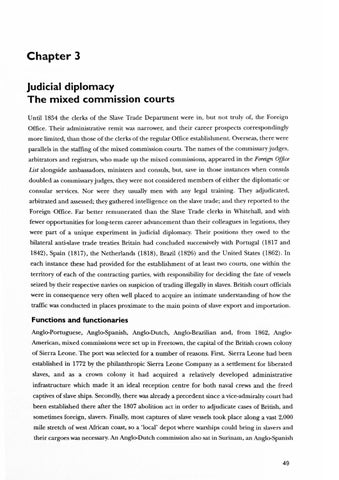Chapter 3 Judicial diplomacy The mixed commission courts Until 1854 the clerks of the Slave Trade Department were in, but not truly of, the Foreign Office. Their administrative remit was narrower, and their career prospects correspondingly more limited, than those of the clerks of the regular Office establishment. Overseas, there w re parallels in the staffing of the mixed commission courts. The names of the commissary judges, arbitrators and registrars, who made up the mixed commissions, appeared in the Foreign Office List alongside ambassadors, ministers and consuls, but, save in those instances when consuls
doubled as commissary judges, they were not considered members of either the diplomatic or consular services. Nor were they usually men with any legal training. They adjudicat d, arbitrated and assessed; they gathered intelligence on the slave trade; and they reported to the Foreign Office. Far better remunerated than the Slave Trade clerks in Whitehall, and with fewer opportunities for long-term career advancement than their colleagues in legations, they were part of a unique experiment in judicial diplomacy. Their positions they owed to the bilateral anti-slave trade treaties Britain had concluded successively with Portugal (1817 and 1842), Spain (1817), the Netherlands (1818), Brazil (1826) and the United States (1862). In each instance these had provided for the establishment of at least two courts, one within the territory of each of the contracting parties, with responsibility for deciding the fate of vessels seized by their respective navies on suspicion of trading illegally in slaves. British court officials were in consequence very often well placed to acquire an intimate understanding of how the traffic was conducted in places proximate to the main points of slave export and importation.
Functions and functionaries Anglo-Portuguese, Anglo-Spanish, Anglo-Dutch, Anglo-Brazilian and, from 1862, AngloAmerican, mixed commissions were set up in Freetown, the capital of the British crown colony of Sierra Leone. The port was selected for a number of reasons. First, Sierra Leone had been established in 1772 by the philanthropic Sierra Leone Company as a settlement for liberated slaves, and as a crown colony it had acquired a relatively developed administrative infrastructure which made it an ideal reception centre for both naval crews and the freed captives of slave ships. Secondly, there was already a precedent since a vice-admiralty court had been established there after the 1807 abolition act in order to adjudicate cases of British, and sometimes foreign, slavers. Finally, most captures of slave vessels took place along a vast 2,000 mile stretch of west Mrican coast, so a 'local' depot where warships could bring in slavers and their cargoes was necessary. An Anglo-Dutch commission also sat in Surinam, an Anglo-Spanish
49
